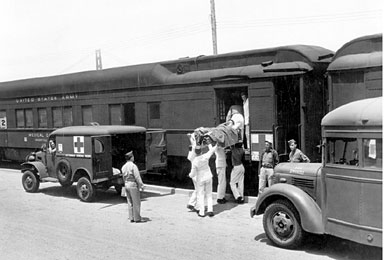A legacy from heroes of World War II
The late Sherwin Staples, M.D., the founder and first chief of DHMC's orthopaedics section, didn't think of himself as a hero when he was tending to wounded soldiers during World War II. But today, all the orthopaedic surgeon veterans of that war are being honored by the American Academy of Orthopaedic Surgeons (AAOS) with an exhibit commemorating their heroic stories.
As part of the recent launch of orthopaedics as a separate department, not just a section within the surgery department, DHMC hosted the AAOS's "Legacy of Heroes" exhibit and invited one of the veterans celebrated in it, Zachary Friedenberg, M.D., to speak at Dartmouth. Friedenberg enthralled the DHMC audience with his retrospective review of surgery in a WWII field hospital. He had been a tent mate and friend of Staples, who went on to head DHMC's orthopaedics section for nearly 30 years. The AAOS's project includes a documentary film, a book, a Web site, and the traveling exhibit—which comprises 20 seven-foot-tall multisided towers. Friedenberg, a professor of orthopaedic surgery at the University of Pennsylvania, considers Staples, who died last year at the age of 94, to have been one of his mentors. He recalls him fondly as a "deliberate, conscientious individual, full of good cheer."

|
|
The WWII "Legacy of Heroes" exhibit contained many striking images. |
But the two were far from cheerful when they discovered, to their horror, that some of the wounded American soldiers who had been prisoners of war had had metal rods placed inside fractured leg bones. "We thought it was one of [the Germans'] experiments on human guinea pigs," says Friedenberg. In those days, fractures were typically treated by putting the leg in traction for four to six weeks. The Germans, however, had found a better way to set the bones, but the war had impeded the free exchange of scientific information so U.S. doctors didn't know about the advance. The use of intramedullary nails has since become standard practice, Friedenberg says.
In fact, many advances in orthopaedics had their origins during WWII. Orthopaedic surgeons were once called "strap and buckle doctors," because all they could do was put people in braces. But during the war, surgeons developed better techniques for setting fractured bones, performing hand surgery, and minimizing infections in wounds, as well as providing physical therapy and prosthetics for those who'd had had limbs amputated.
L.S.C.
If you would like to offer any feedback about this article, we would welcome getting your comments at DartMed@Dartmouth.edu.
